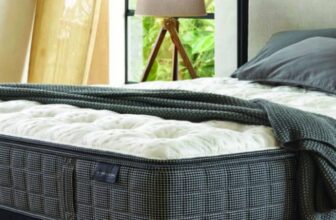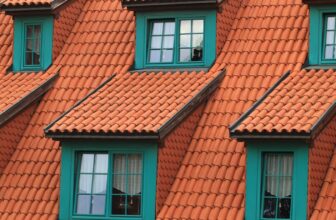Texture Mud Vs. Joint Compound – What’s The Difference?
Applying the finish to the drywall is one of the final steps in building a new house or renovating an old one.
But also one of the most essential as it will have a great impact on how the interior of your house will look.
There are various types of finishes that can be used to hide surface imperfections and make the whole wall surface look impeccable and uniform.
However, finishes can also be used to achieve a specific visual styling and make the wall look more natural or rustic.
Depending on what you want to achieve, you’re likely to use either texture mud or joint compound.
So, learning the differences between the two is important, especially for inexperienced DIYers.
To help out, I’ll compare texture mud vs joint compound, so you can figure out which one will better suit your needs.
| Texture Mud | Joint Compound | |
| Texture | Used to create texture on walls or ceilings | Used to cover joints between drywall sheets and smooth the surface of walls or ceilings |
| Consistency | Thicker consistency than joint compound | Thinner consistency than texture mud |
| Drying Time | Takes longer to dry than joint compound | Dries faster than texture mud |
| Sanding | Requires less sanding than joint compound | Requires more sanding than texture mud |
| Usage | Primarily used for creating decorative texture on walls or ceilings | Primarily used for covering joints and smoothing surfaces |
Table of Contents
What Is Texture Mud?
Texture mud is a type of finishing compound used to fix and hide the imperfections on the drywall but also create a unique wall texture.
It may come pre-mixed or in form of powder, in which case, you have to mix and prepare it yourself.
Although the latter alternative is a bit more complicated, it provides more options when it comes to the type and consistency of wall texture.
The texture and holding capacity can also be improved by adding some sand to the compound.
To achieve the desired texture, you also have to properly prepare the wall surface, which includes claiming the area where you will apply the texture mud with a tri-sodium phosphate solution and allowing some time to dry.
To improve the texture mud adhesion, you can first apply the deglosser and prime the surface by sanding it.
What is Joint Compound?
A joint compound, also known as a drywall compound is a mixture primarily made of primary gypsum and limestone, although it can feature other ingredients, such as perlite, clay, mica, or starch.
It can come in the form of powder or as a pre-mixed wet joint compound which is easier to use and better for DIY projects.
In general, its consistency is similar to mud, which is why it’s often referred to as drywall mud, but it may have different densities, depending on the type.
The main area of application for joint compounds is to smooth and seam new drywall installation, commonly on bigger projects or when building a new house.
However, it can also be used for smaller repairs, such as fixing small holes or smoothing out wall dents.
There are different types of joint compounds and which one you will use will depend on the type of the project.
Texture Mud Vs. Joint Compound – What’s The Difference?
Texture mud and joint compound have a lot in common.
Both have a similar primary purpose – to hide drywall imperfections, and both are available in pre-mixed and dry powder form.
However, it’s the differences between the two that should play a role when deciding which one to use.
Below is a short rundown of what separates texture mud and joint compound.
Thickness
One of the differences between texture mud and joint compound that is the easiest to notice is in their thickness.
Texture mud is the thinner of the two and this allows for better application of the texture you want to use.
On the other hand, the greater thickness of the joint compound makes it easier and less challenging to use, less prone to cracking over time, and more durable.
The Simplicity of Use
While applying finish to the drywall is not too complex of a process, it still requires some level of expertise and experience.
This is particularly the case with texture compounds as it may be challenging to get the exact look you want.
So, you may be better off hiring a professional to do it for you.
A joint compound is much simpler to use, and, therefore, more suitable for DIY projects.
Durability
Of course, one of the main things you will be concerned about when applying finish to the drywall is how long it’s going to last, as a more durable finish means less frequent repairs and cheaper maintenance.
As the joint compound is thicker than the texture mud, it’s less likely to crack or peel off and, therefore, will be more durable once applied to the drywall.
Finish
The difference between the texture mud and joint compound that is the most obvious to the naked eye is in the visual appearance of the finish.
As its name says, texture mud provides a textured finish, giving the wall a sort of rustic and natural look, rather than a fully flat surface.
On the other hand, after applying joint compound, you should have a perfectly smooth wall finish.
This also impacts how you’re going to prepare drywall before the application of these two compounds.
Unlike texture mud, the joint compound should be applied to a perfectly flat surface, so you may have to do some sanding to achieve it.
Shrinkage
When using texture mud, you may notice that it tends to shrink after it settles.
Depending on the level of shrinkage, this may mean that you’ll have applied another layer, which can be annoying, not to mention time-consuming.
The joint compound shrinks much less, which makes it better for sealing off small holes or drywall tape at the joints.
Conclusion
Both texture mud and joint compound have their advantages and each is frequently used for various home projects.
Which one you will use will depend on what you want to do, as well as on your available budget.
Texture mud is great when trying to add some visual style to your interior but as it shrinks more and is thinner than joint compound, it’s more suited for use on smaller surfaces.
Joint compound is cheaper and easier to use and apply, so you may want to choose it for larger projects when you have to apply it to a greater surface.
So, make sure to carefully consider the requirements of the job you’re about to do and choose the right type of finish as it can make all the difference.



















































































